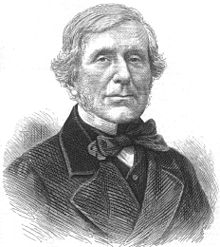John Rennie the Younger
| John Rennie | |
|---|---|

John Rennie the Younger
|
|
| Born | 30 August 1794 Southwark, London |
| Died | 3 September 1874 (aged 80) Bengeo, Hertfordshire |
| Nationality | English |
| Engineering career | |
| Discipline | civil engineer |
| Institutions | Institution of Civil Engineers (president) |
| Projects | Waterloo Bridge Southwark Bridge London Bridge |
Sir John Rennie (30 August 1794 – 3 September 1874) was the second son of engineer John Rennie, and brother of George Rennie.
John Rennie was born at 27 Stamford Street, Blackfriars Road, London, on 30 August 1794. He was educated by Dr. Greenlaw at Isleworth, and afterwards by Dr. Charles Burney at Greenwich. He subsequently entered his father's manufactory in Holland Street, Blackfriars Road, where he acquired a practical knowledge of his profession, and in 1813 he was placed under Mr. Hollingsworth, resident engineer of Waterloo Bridge, the foundations of which he personally superintended. In 1815 he assisted his father in the erection of Southwark Bridge, and in 1819 he went abroad for the purpose of studying the great engineering works on the continent.
On the death of his father in 1821, John remained in partnership with his brother George, the civil engineering portion of the business being carried on by him, whereas the mechanical engineering was supervised by George.
Rennie along with Philip Richards designed Royal William Victualling Yard, Plymouth, (1823–33). Covering 14 acres (57,000 m2), this grand classical style ensemble built from Plymouth limestone and Dartmoor granite, consists of grand gateway surmounted by statue of King William IV, there is the Slaughterhouse, then around a central dock basin, to the south Melville Square, a warehouse with a central courtyard, it has a clock tower over the main entrance, to the west of the basin is the Bakery with its mill and to the east the Brewery, with its cooperage.
Rennie also was responsible for designing Cannon Workshops, which arose following the strike by the coopers employed by the West India Dock Company. The company decided to reorganise the cooperage Department, and Rennie drew up the plans, submitting them in 1824. The buildings were completed in 1825.
The most important of John Rennie's undertakings, from 1824, was the construction of London Bridge, the designs for which had been prepared by his father. The bridge was opened in 1831, when Rennie was knighted, being the first of the profession since Sir Hugh Myddleton to be thus distinguished. He was responsible for the New River Ancholme Drainage Scheme in Lincolnshire, and Horkstow Bridge, which he designed to cross the river at Horkstow in 1835–6, is one of the earliest suspension bridges to survive and remains substantially as designed. As engineer to the admiralty, a post in which he succeeded his father, he completed various works at Sheerness, Woolwich, Plymouth, Ramsgate, and the great breakwater at Plymouth, of which he published an 'Account' in 1848. Many years of his life were spent in making additions and alterations to various harbours on different parts of the coast, both in England and in Ireland. One example would be his work in the 1850s designing a drydock for Joseph Wheeler at his Rushbrooke yard in Cork. He completed the drainage works in the Lincolnshire fens commenced by his father, and, in conjunction with Telford, constructed the Nene outfall near Wisbech (1826–1831). He also restored the harbour of Boston in 1827–8, and made various improvements on the Welland. He also re-modernised the Chatham Dockyards in 1862. Creating 3 huge basins and passageways.
...
Wikipedia
